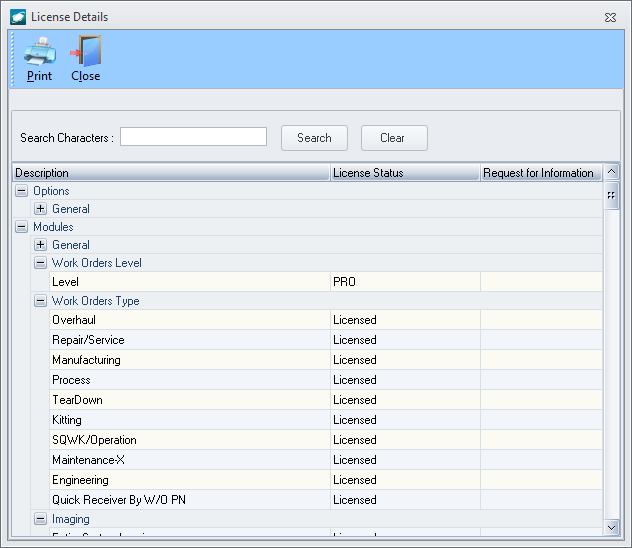Purpose:
To
describe the features of the Component Work Order modules.
Description
Component work order modules have a variety of function based upon type:
- Overhaul - Designed
to manage the overhaul of assemblies received from customers or internal
stock. Requires that an assembly is pulled from the warehouse. Components
may be removed from and/or installed on the assembly. Once overhaul
is completed, the assembly is placed back into the warehouse.
- Repair/Service
- Designed to manage the repair or service of assemblies received
from customers or internal stock. Requires that an assembly is pulled
from the warehouse. Components may be removed from and/or installed
on the assembly. Once repair/service is completed, the assembly is
placed back into the warehouse.
- Manufacturing
- Designed to manage the manufacture of assemblies ordered by the
customer or for stock. Allows a work order to be created without pulling
an assembly from the warehouse. Instead, the assembly that will result
from the work order is simply identified. Components may be added
to the assembly. After manufacture, the assembly is placed into the
warehouse.
- Process - Designed
to manage the modification of a part or material using one or more
outside processes (no process will be performed in-house). Requires
that material or an assembly to be pulled from the warehouse. The
material or assembly is modified utilizing one or more outside services.
Once the modification is complete, the material or assembly is placed
into the warehouse.
- Teardown - Designed
to manage tear down of assemblies in order to utilize the components
as spare parts. Requires that an assembly is pulled from the warehouse.
Components may be removed from the assembly. Once disassembly is completed,
the original assembly is considered consumed and all of the components
are placed into the warehouse.
- Kitting - Designed
to manage the assembly of kits ordered by the customer or for stock.
Allows a work order to be created without pulling an assembly from
the warehouse. Instead, the kit that will result from the work order
is simply identified. Components may be added to the kit. After assembly,
the kit is placed into the warehouse.
- Squawk/Service
- Designed to be a descriptive type of work order that may be associated
with an aircraft and/or customer. Allows a work order to be created
and associated with a part number without pulling it from the warehouse.
Components may be associated with the work order. Once the work is
complete, there is no part to be placed into the warehouse.
- Maintenance-X
- Designed to be a descriptive type of work order that is associated
with an aircraft and/or customer. Allows a work order to be created
and associated with a part number without pulling it from the warehouse.
Components may be associated with the work order. Once the work is
complete, there is no part to be placed into the warehouse.
- Engineering
- Designed to be a descriptive type of work order that may be associated
with an aircraft and/or customer and is related to engineering. Allows
a work order to be created and associated with a part number without
pulling it from the warehouse. Components may be associated with the
work order. Once the work is complete, there is no part to be placed
into the warehouse.
In addition, there are two different levels of work orders:
- Standard
- Designed for situations where no sub-work orders are required. Enables
management of work orders where all work can be tracked on a single-level
work order.
- Pro - Designed
for situations where the requirement for sub-work orders is possible.
Enables tracking an unlimited number sub-work orders which are linked
to the parent work order for cost and labor tracking purposes.
Licensing
Component work order modules are licensed by work order type.
From the License Details (link pending)
window, go to the Work Orders Type section
of the Modules section.

- The Overhaul
line will identify whether or not your license allows Overhaul
component work orders.
- The Repair/Service
line will identify whether or not your license allows Repair/Service
component work orders.
- The Manufacturing
line will identify whether or not your license allows Manufacturing
component work orders.
- The Process
line will identify whether or not your license allows Process
component work orders.
- The TearDown
line will identify whether or not your license allows Teardown
component work orders.
- The Kitting
line will identify whether or not your license allows Kitting
component work orders.
- The SQWK/Operation
line will identify whether or not your license allows Squawk/Service
component work orders.
- The Maintenance-X
line will identify whether or not your license allows Maintenance-X
component work orders.
- The Engineering
line will identify whether or not your license allows Engineering
component work orders.
In addition, the work order level is identified on the Level
line of the Work Order Level section.
Access
This module may be accessed utilizing multiple methods:
- From the main menu screen:
- Left-click the Operations
button; the Operations window
will appear.
- Left-click the Work
Orders button; the Component
Work Orders Menu window
- Double-click .
- From the ribbon:
- Left-click Operations.
- Left-click
the Component Work Orders button.
- Left-click .
- From the shortcut menu:
- Left-click Operations.
- Go
to .
- Left-click .


